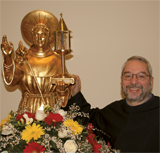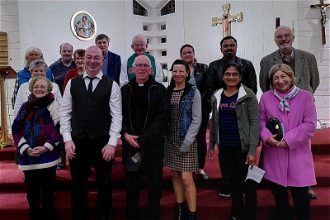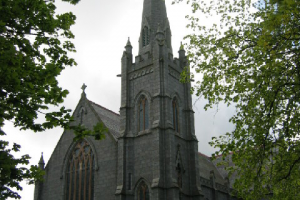St Anthony’s Relics tour attracts 350,000 people

Fr Mario with the Reliquary
The Franciscan Greyfriar who accompanied St Anthony of Padua’s relics on their recent tour of Ireland and the UK has described the visit as a “tremendous success”. The 17-venue tour, which ended in London last weekend, drew more than 350,000 people.
Padua-based Fr Mario Conte, who is editor of the Messenger of St Anthony magazine international edition, said “everywhere, people were wonderful and clergy were ecstatic at the huge numbers attending, which included 30,000 people who queued all day in the rain outside St John’s Cathedral in Limerick on 21 October, and similar numbers the next day at Galway Cathedral”.
Despite feeling exhausted after being on the road with the relics since 17 October, Fr Mario reported that “everywhere people wanted to tell me their stories about how Anthony found a lost item or helped them in a specific way”. At the opening Mass of the tour in Dublin, Archbishop Diarmuid Martin said: “this evening we turn to St Anthony of Padua with the intentions that are in the hearts of each of us and with the intentions of those who have asked us to pray for them, and we do so with trust in the power of God which works through the intercession of this saint”.
The relics - a small piece of rib bone and a layer of cheek skin normally kept at the Basilica of St Anthony in Padua – were displayed in a 70 cm high golden statue of St Anthony and a reliquary.
Bishop Anthony Farquhar of Down and Connor celebrated Mass in Belfast on 24 October, after four hours of veneration where pilgrims of all ages stretched out beyond the entrance porch and past the gates of St Peter’s Cathedral. The administrator of the cathedral, Fr Hugh Kennedy, reported that, “what I personally found moving was the long distances some had travelled to be present and often, having venerated the relics, spent a prolonged period of prayer and reflection in the cathedral. He added that “it was a remarkable testimony of the sincere and strong devotion to St Anthony that still exists among so many Irish people”.
Two days later, the relics visited Scotland, specifically Glasgow and Aberdeen. St Mary’s Cathedral in Aberdeen filmed Fr Mario’s homily during Mass and put it up on the parish website. The first host church in England was St Anthony of Padua Church in Walker, Newcastle upon Tyne on 28 October. Its parish priest, Fr Michael Conaty, said that the visit of the relics to his inner city parish was an “extraordinary success” with approximately 5,500 travelling to venerate the relics. “We had coaches from Whitby, Leeds, Scotland and Carlisle bringing people across” he reported. From there, the relics visited Manchester, where a BBC film crew followed queues of around 2,000 people on 29 October, and Liverpool, where more than 2,500 people came from a 200 mile radius, including the Scottish borders and the Birmingham area. “It was heartwarming and encouraging to see the devotion to St Anthony” said Fr Vincent Kennedy.
Catholics turned out in their thousands to venerate the relics at a Franciscan church in Chester on 31 October. The city centre Church of St Francis was full to capacity for a mass celebrated by Bishop Mark Davies of Shrewsbury Diocese. In his homily, Bishop Davies reminded pilgrims that they too were called to be saints and he prayed that St Anthony would, “help us by his example and prayer never to lose sight of the one goal of our lives – that you and I might be counted among all the saints”.
At Westminster Cathedral last Saturday, where there was a constant queue of people all afternoon waiting to venerate the relics, Fr Mario was applauded by a packed congregation at the evening Mass when he told them that, “there is nothing superstitious about relics; the real meaning of a relic is love – they are a link of love between the person who venerates and the saint”. During his homily at the Mass, Archbishop Vincent Nichols suggested that St Anthony is a guide to those who have lost their way in life and want to return to their true path. He said: “On this most fundamental of all journeys we often get lost, taking a wrong path, ending up in a cul-de-sac, distracted by bright lights or misjudgement. St Anthony is well known for helping us to find lost things. And he can help us in this way too.”
The relic tour of Ireland and Britain concluded in East London with queues surrounding St Peter’s Italian Church in Clerkenwell for the six hours of veneration. The visit took place to mark the 750th anniversary of the opening of St Anthony’s coffin by the then head of the Franciscan Order, St Bonaventure, 32 years after Anthony’s death in 1231. The saint’s tongue was said to have been fully preserved, a miracle which is said to reflect his oratory skills. He was proclaimed a Doctor of the Church on 16 January 1946.


















